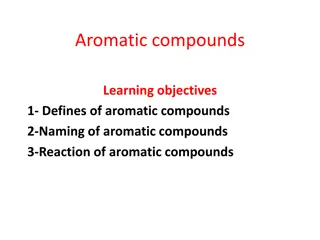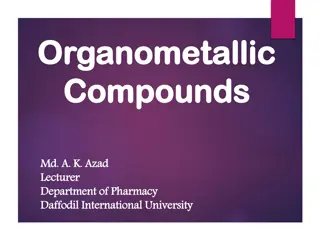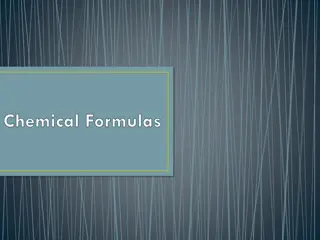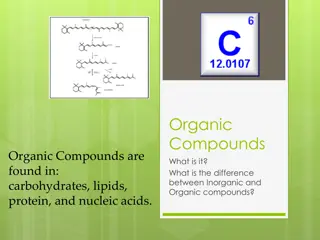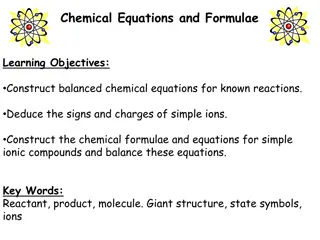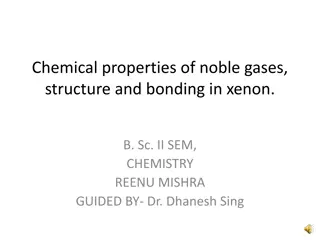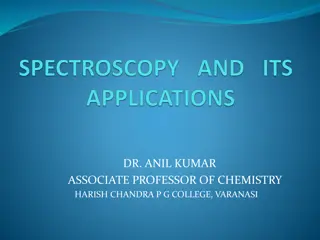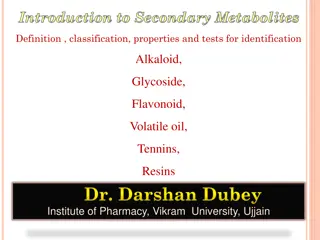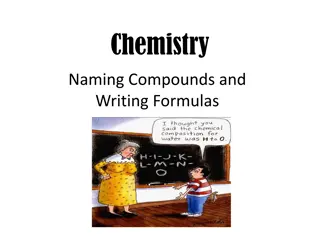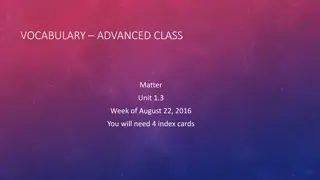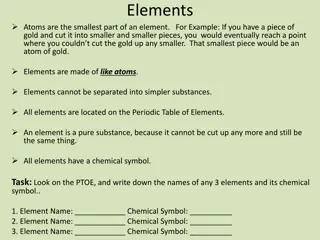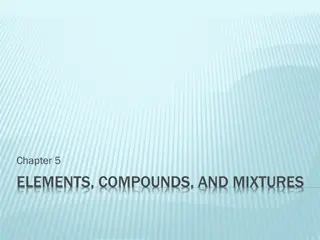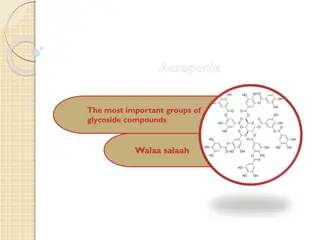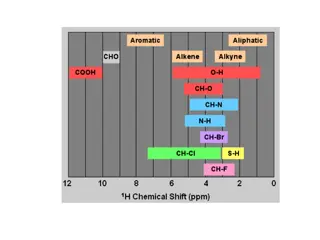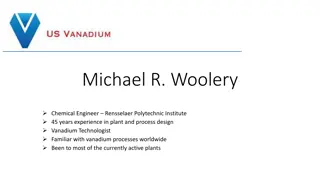Aromatic compounds
Aromatic compounds are chemical compounds containing a ring with delocalized pi electrons. Learn about the definition, naming conventions, and reactions of aromatic compounds such as benzene. Explore topics like aryl groups, halogenation reactions, and the mechanism for bromination of benzene.
0 views • 19 slides
Organometallic Compounds of Group 2 Elements
In the realm of organometallic chemistry, Group 2 elements, specifically alkaline earth metals like beryllium and magnesium, exhibit intriguing properties and reactivities. The chemistry of these elements, mimicking that of Group 12 elements in many aspects, leads to the formation of various organom
5 views • 27 slides
Understanding Organometallic Compounds and Their Applications
Organometallic compounds are compounds with a bond between a metallic element and a carbon atom from an organic molecule. They have diverse properties and applications, ranging from being toxic to facilitating commercial chemical reactions. Learn more about their preparation, properties, and various
0 views • 10 slides
Chemical Agents Awareness Training Overview
This training module covers standardized awareness and authorized training on chemical agents, including toxic industrial chemicals, riot control agents, and chemical warfare agents. Participants will learn about the physiological signs/symptoms, advantages/disadvantages of using chemical agents for
1 views • 20 slides
Understanding Chemical Formulas, Reactions, and Equations
Explore the world of chemical formulas, reactions, and equations, understanding how they identify substances and represent the composition of compounds. Learn about the significance of balanced chemical equations and the role of subscripts in indicating the number of atoms present in a molecule. Dis
1 views • 44 slides
Enhancing Chemical Formula Writing Skills for Students
This action research focuses on improving students' ability to write and name chemical formulas. The study addresses challenges in understanding and applying chemical concepts in a general chemistry course. Strategies include utilizing worksheets, group collaboration, and mobile applications to enha
2 views • 13 slides
Understanding Organic Compounds and Their Importance in Daily Life
Explore the world of organic compounds, including their definition, difference from inorganic compounds, common elements found in them, and the significance of hydrocarbons. Learn about the essential role of organic compounds in living organisms, such as proteins, carbohydrates, and fats, and how th
1 views • 51 slides
Understanding Chemical Equations and Formulae
Learn to construct balanced chemical equations for known reactions, deduce signs and charges of simple ions, and create chemical formulae for ionic compounds. Understand the concepts of reactants, products, molecules, giant structures, state symbols, and chemical formulas for various substances. Gai
3 views • 7 slides
Understanding Biosynthetic Pathways in Living Organisms
Biosynthesis, also known as anabolism, involves the formation of complex organic compounds from simple subunits catalyzed by enzymes within living organisms. This process is vital for the development of life and the production of essential compounds like carbohydrates, proteins, vitamins, antibiotic
1 views • 21 slides
Mastering Compound Naming for Chemistry Students
Develop your ability to name compounds and write their chemical formulas with ease by understanding the naming conventions for different compound types. Learn about compounds composed of metal and non-metal elements, compounds containing oxygen, and those made only of non-metals. Practice naming spe
2 views • 14 slides
Chemical Properties and Bonding in Xenon: A Study of Noble Gases
Noble gases, including xenon, exhibit unique chemical properties due to their stable electron configurations. Xenon forms compounds like xenon difluoride, xenon tetrafluoride, and xenon hexafluoride, showcasing various hybridization states and geometries. These compounds illustrate the reactivity of
0 views • 18 slides
Overview of Anticestodal Drugs in Veterinary Pharmacology
Anticestodal drugs play a crucial role in combating tapeworm infections in veterinary medicine. These drugs are classified into taeniafuges and taenicides, with examples of natural and synthetic compounds highlighted. Natural compounds like pumpkin seeds and male fern are traditionally used for thei
0 views • 29 slides
Separation and Purification of Organic Compounds: Methods and Techniques
The separation and purification of organic compounds are essential processes to obtain pure products, as impurities and side reactions can affect the quality of the compounds. Methods such as solution and filtration, crystallization, distillation, extraction, sublimation, and chromatography are comm
8 views • 15 slides
Understanding Matter through LEGO Building Blocks
Explore the concept of elements and compounds by sorting LEGO blocks based on color and creating models to represent atoms and compounds. Learn about chemical bonding and how to depict different elements and compounds using LEGO pieces in an engaging hands-on activity.
0 views • 16 slides
Structural Elucidation of Chemical Compounds Using Spectroscopy Techniques
This presentation discusses the various types of spectroscopy techniques such as UV-Visible, IR, Raman, NMR, and others used for elucidating the structure of chemical compounds. It covers the identification of molecule shapes like AB2, AB3, and AB4, with a focus on linear and non-linear structures.
0 views • 18 slides
Identification of Cardioactive Glycosides Through Chemical Tests
The laboratory experiments focus on identifying cardioactive glycosides through chemical tests like Baljets Test and Keller-Killians Test. These tests involve reactions with specific reagents to observe color changes and layer formations, helping in the identification of different parts of the glyco
2 views • 11 slides
Solubility Rules from the University of South Carolina
This resource outlines the solubility rules for various compounds based on their chemical properties. It explains the solubility of compounds of alkali metals, ammonium salts, nitrates, chlorides, sulfates, and more. The rules provide insights into which compounds are soluble or insoluble in aqueous
1 views • 10 slides
Enhancing Synergies for Resilient Tomorrow: Chemical Waste Management Project Overview
Enhancing Synergies for a Resilient Tomorrow outlines a project aimed at strengthening the Federated States of Micronesia's capacity in chemical management. The project focuses on monitoring and evaluating chemical use, enhancing legislative frameworks, and establishing a central database for chemic
1 views • 12 slides
Understanding the Role of Starter Culture in Fermented Milk Products
Starter cultures play a crucial role in the production of fermented milk products by producing antimicrobial compounds like organic acids, H2O2, CO2, aroma compounds, fatty acids, and bacteriocins. These compounds help prevent spoilage by inhibiting the growth of harmful bacteria and altering cellul
6 views • 9 slides
Alkaloids and Heterocyclic Compounds: A Comprehensive Overview
Alkaloids are natural compounds containing nitrogen, with various pharmacological activities. Heterocyclic compounds, essential to life, include a diverse range of compounds such as alkaloids, antibiotics, and vitamins. The lecture delves into the properties, classifications, and examples of these c
12 views • 7 slides
Chemical Bonding and Compound Formulas: Understanding Ionic vs. Covalent Bonds
Explore the differences between ionic and covalent bonds, learn about ionic compounds held by electromagnetic attractions, understand molecular compounds with shared electrons, and grasp the naming conventions for ions. Discover how molecular formulas and formula units represent atoms in compounds.
0 views • 56 slides
Overview of Secondary Metabolites: Alkaloids, Glycosides, Flavonoids, and More
Secondary metabolites are chemical compounds produced by plants that have various biological effects. Alkaloids, a type of secondary metabolite, are organic compounds with nitrogen atoms and specific physiological actions. They exhibit diverse physical and chemical properties, making them essential
0 views • 63 slides
Chemistry: Naming Compounds and Writing Formulas
Understand compounds, chemical formulas, and how to write ionic formulas using the Swap 'n Drop Method. Learn about types of compounds - ionic, covalent, and acids, and practice writing formulas for various elements. Follow rules, naming flow charts, and partner activities to enhance your understand
0 views • 13 slides
Overview of Chemical Reactor Design and Operation
Chemical reactor design involves studying the rates and mechanisms of chemical reactions, as well as the design of reactors for these reactions on a commercial scale. This field combines principles from thermodynamics, chemical kinetics, fluid mechanics, mass transfer, heat transfer, and economics t
0 views • 12 slides
Understanding Chemical Changes and Reactions
Explore the concepts of chemical and physical changes, including balancing chemical equations, physical properties, and examples of chemical reactions. Learn to distinguish between physical and chemical changes through visual aids and learning checks.
0 views • 24 slides
Understanding Matter: Physical and Chemical Changes Explained
Explore the nature of matter through the concepts of physical and chemical changes. Learn to distinguish between physical changes where the form or shape of a material alters without new substances forming, and chemical changes which result in the creation of new compounds. Discover reactivity in ch
0 views • 9 slides
Understanding Chemistry: Elements, Molecules, Compounds, and Mixtures Flow Chart
In the world of chemistry, elements are the building blocks represented on the Periodic Table, while molecules and compounds are formed by atoms bonding together. Mixtures, on the other hand, involve a combination of substances without chemical bonding. Physical and chemical properties define matter
0 views • 7 slides
Exploring Elements, Compounds, and Mixtures: A Classroom Review Activity
In a classroom review activity with tables labeled as left, middle, and right, various elements, compounds, and mixtures were discussed. The review involved identifying substances such as gold (Au), water (H2O), iron (Fe), and chicken soup. Through these examples, students learned to differentiate b
0 views • 28 slides
Understanding Organic Chemistry and Macromolecules
Organic chemistry focuses on compounds with carbon bonds, while inorganic chemistry deals with other compounds. Carbon is unique due to its ability to form multiple bonds, creating diverse structures like chains and rings. Organic compounds, produced by living organisms, range from simple to complex
0 views • 32 slides
Understanding Elements, Compounds, and Mixtures in Chemistry
Explore the world of matter through elements, compounds, and mixtures. Learn about the differences between physical and chemical changes, as well as the properties of pure substances. Discover the characteristics of elements and compounds, along with the concept of chemical formulas. Dive into the r
0 views • 26 slides
Exploration of Fossils and Compounds in Science Learning
Archaeologists search for fossils in specific types of rocks, while students learn about compounds and their formation through engaging activities. Compounds are combinations of two or more elements, each with distinct naming conventions. Students practice naming compounds based on their constituent
0 views • 10 slides
Understanding Chemotaxonomy: Classification of Plants Based on Chemical Constituents
Chemotaxonomy, presented by Dr. R. P. Patil, explores the scientific investigation of the chemical characters in plants for taxonomy and phylogeny studies. It involves classifying plants based on their chemical constituents and molecular characteristics. Principles, methods, and importance of chemot
0 views • 24 slides
Understanding Physical and Chemical Changes in Science Class
Explore the concepts of physical changes and chemical reactions in this interactive science lesson. Students will differentiate between the two types of changes, identify evidence for each, categorize examples, and discuss key concepts with their peers at the table. Through videos and discussions, t
0 views • 21 slides
ASU EHS & FSE Chemical Approval Process Guidelines
Detailed guidelines and forms for the chemical approval process at ASU, including links to important resources, forms for new chemical purchases and transfers, responsibilities for lab managers, and procedures for chemical transfers. The process involves completing forms such as the Prior Approval A
0 views • 5 slides
Understanding Ionic and Molecular Compounds in Chemistry
Discover the fundamental concepts of ionic and molecular compounds in chemistry with insights into the nature of elements, formation of compounds, and properties of ions. Explore the differences between ionic and covalent bonds, positive and negative ions, as well as examples of common everyday comp
0 views • 54 slides
Understanding Ionic Bonding and Lattice Energy in Chemistry
Chemical bonds play a crucial role in holding atoms together in molecules. This course explores the concept of chemical bonding, focusing on ionic bonds and lattice energy. Topics covered include the different types of chemical bonds, such as electrovalent and coordinate bonds, as well as the models
0 views • 22 slides
Overview of Important Glycoside Compounds and Their Properties
Glycoside compounds play a significant role in various biological processes, with groups like steroids and cardenolides showcasing notable medicinal effects. Steroids are crystalline substances with specific solubility characteristics, while cardenolide glycosides are known for their toxic effects o
0 views • 13 slides
Comparative Analysis of Amide, Imide, and Urea Compounds in Chemical Testing
This analysis delves into the properties and chemical reactions of amide, imide, urea, and related compounds like sulphanilamide and phthalimide. It explores their characteristics such as odor, solubility, and reactions to different tests like acid-base testing and preliminary examinations. The disc
0 views • 10 slides
NMR Spectroscopy Data Analysis for Organic Compounds
This dataset contains NMR spectroscopy data for various organic compounds, including their chemical shifts (ppm), peak areas, and molecular formulas. The information can be used for spectral analysis and identification of chemical structures.
0 views • 20 slides
Insights into the Vanadium Industry and Chemical Compounds
Michael R. Woolery, a Chemical Engineer with extensive experience in vanadium processes, sheds light on the U.S. vanadium industry, sodium orthovanadate compound, toxicokinetic properties of organic vs. inorganic vanadium compounds, environmental exposure sources, and the impact of reference doses o
0 views • 6 slides
